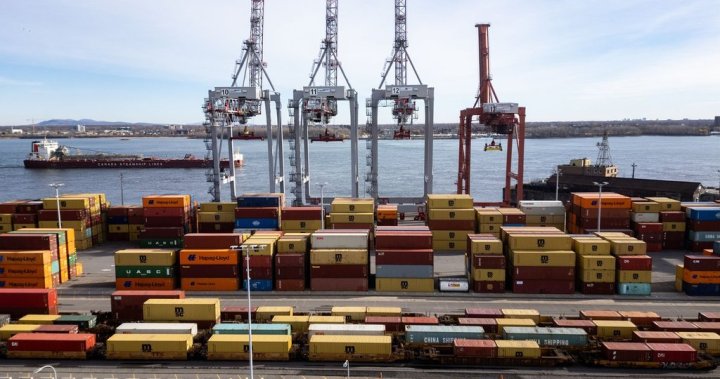The Canadian economy showed signs that it has been working to pivot away from doing business with the United States, according to new data from Statistics Canada.
That comes as U.S. President Donald Trump’s tariffs and trade war have forced many businesses to seek alternative trading partners to avoid impacts and higher costs.
“Trade diversification is still advancing, and we’re seeing encouraging gains in other markets,” says principal economist Andrew DiCapua at the Canadian Chamber of Commerce.
“The worst may be behind us, but the road back will likely be uneven.”
In May, Statistics Canada reports the total amount of merchandise exported increased by 1.1 per cent compared with April, led by metals including gold, silver and platinum to countries like the United Kingdom, as well as non-metallic mineral products.
Imports fell 1.6 per cent, marking the third straight monthly decline, the agency said, which helped narrow the overall trade deficit from $7.6 billion in April to $5.9 billion in May.
Get breaking National news
For news impacting Canada and around the world, sign up for breaking news alerts delivered directly to you when they happen.
A trade deficit occurs when the amount an economy imports, or buys, is more than the amount it exports, or sells.
The agency also reports that in May, the amount Canada exported specifically to the U.S. fell by 0.9 per cent, marking the fourth consecutive monthly decline, and exports to countries other than the U.S. rose 5.7 per cent to reach a record high.
Although expectations of higher costs from Trump’s tariff policies may have motivated businesses to look away from the U.S., economists note that the numbers show these higher costs from tariffs haven’t yet fully materialized.
“Ninety-one per cent of Canadian exports to the U.S. crossed the border duty-free, consistent with the view that the exemption for CUSMA/USMCA-compliant trade from blanket U.S. tariffs imposed in March is working effectively,” economist Nathan Janzen at Royal Bank of Canada says.
“We continue to expect that current rules, if maintained as currently in place, would leave Canada with the lowest tariff rate of any major U.S. trade partner — putting Canadian exporters in a stronger relative position to compete for U.S. import market share than other countries.”
Tariff measures are more costly for goods and services that do not meet the requirements of the Canada United States Mexico Agreement (CUSMA/USMCA). Prime Minister Mark Carney has been working with Trump on the terms for a new trade deal.
This data from Statistics Canada comes just weeks ahead of the July 21 deadline for Canada and the U.S. to reach a new trade deal, or there could be further tariff escalations.
© 2025 Global News, a division of Corus Entertainment Inc.
Canada’s exports to the U.S. fell again in May as trade war continues


